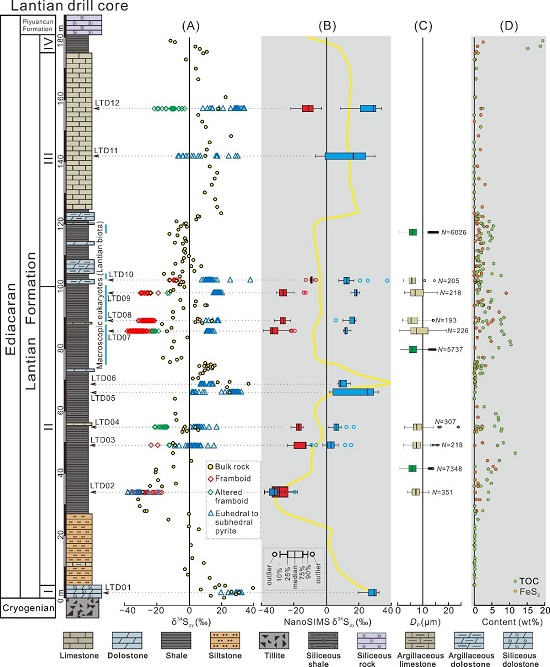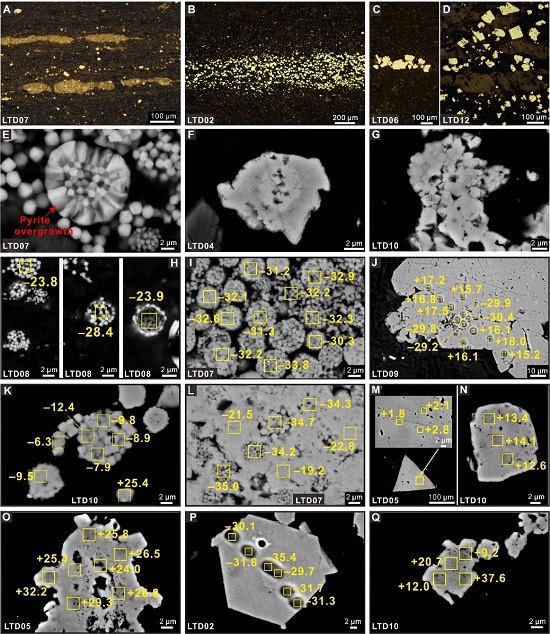Reconstructions of ancient sulfur cycling and redox conditions commonly rely on sulfur isotope measurements of sedimentary rocks and minerals. Ediacaran strata (635–541 Ma) record a large range of values in bulk sulfur isotope difference (Δ34S) between carbonate-associated sulfate (δ34SCAS) and sedimentary pyrite (δ34Spy), which has been interpreted as evidence of marine sulfate reservoir size change in space and time. However, bulk δ34Spy measurements could be misleading because pyrite forms under syngenetic, diagenetic, and metamorphic conditions, which differentially affect its isotope signature. Fortunately, these processes also impart recognizable changes in pyrite morphology.
To tease apart the complexity of Ediacaran bulk δ34Spy measurements, Dr. WANG Wei, Dr. GUAN Chengguo and Prof. ZHOU Chuanming from the Nanjing Institute of Geology and Paleaontology, Chinese Academy of Sciences (NIGPAS), with other researchers from the Institute of Geology and Geophysics, CAS (IGGCAS) used scanning electron microscopy and nanoscale secondary ion mass spectrometry to probe the morphology and geochemistry of sedimentary pyrite in an Ediacaran drill core of the South China block. The relevant results were published online in the internationally renowned journal Geology.
Pyrite occurs as both framboidal and euhedral to subhedral crystals, which show largely distinct negative and positive δ34Spy values, respectively. Bulk δ34Spy measurements, therefore, reflect mixed signals derived from a combination of syndepositional and diagenetic processes. Whereas euhedral to subhedral crystals originated during diagenesis, the framboids likely formed in a euxinic seawater column or in shallow marine sediment. Although none of the forms of pyrite precisely record seawater chemistry, in situ framboid measurements may provide a more faithful record of the maximum isotope fractionation from seawater sulfate. This study exemplifies the fundamental problem with using bulk analyses of sulfur isotopes for paleoenvironmental reconstruction. Given that sulfate concentration is the main controlling factor for sulfur isotope fractionation, the consistently negative δ34S values in framboidal pyrite are suggestive of a larger Ediacaran sulfate reservoir than previously thought.
The study was supported by the National Key Research and Development Program of China, the Chinese Academy of Sciences (CAS), and the National Natural Science Foundation of China.
Reference: Wei Wang*, Yongliang Hu, A. Drew Muscente, Huan Cui, Chengguo Guan, Jialong Hao, Chuanming Zhou*, 2021, Revisiting Ediacaran sulfur isotope chemostratigraphy with in situ nanoSIMS analysis of sedimentary pyrite. Geology, v. 49, https://doi.org/10.1130/G48262.1

Fig.1 Profiles of sedimentary pyrite δ34S values in Lantian Formation drill core

Fig.2 Dominant pyrite morphologies and in situ nanoSIMS sedimentary pyrite δ34S
Download:
